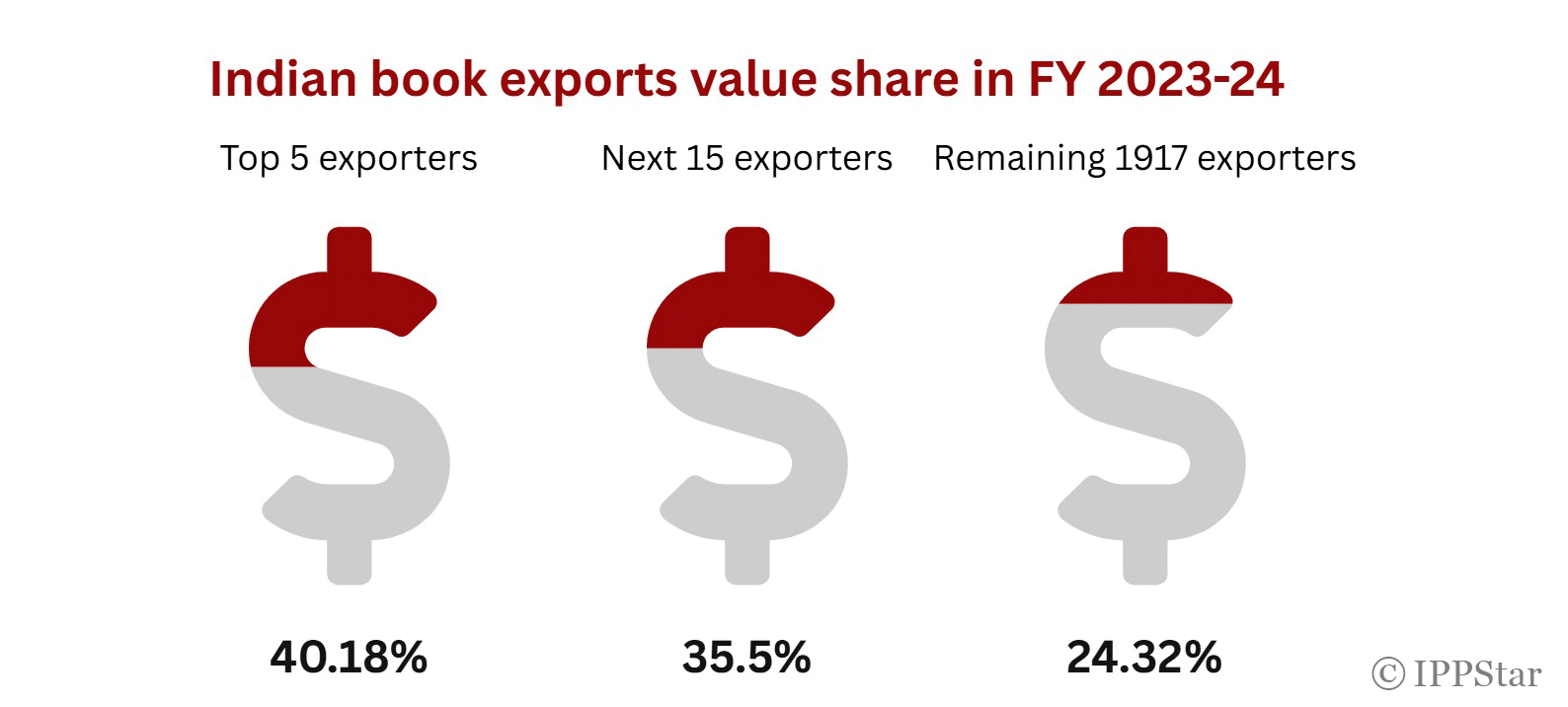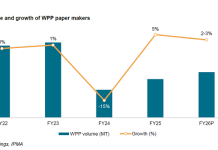According to the hard data (which we think may be a slight underestimate) in the 2023–24 financial year, Indian exporters shipped 120,537 consignments of books to markets around the world. These exports were carried out by 1,937 different exporters, and together they earned about ₹2,454 crore (about US$ 292.16 million). The overall list compiled by IppStar (www.ippstar.org) includes publishers, distributors, printers, and individual exporters.
In the 2024–25 financial year, shipments rose to 138,519—an increase of 14.9%. Even though the number of exporters dipped slightly to 1,843, the total export value climbed to ₹2,603 crore (approximately US$ 310 million). This shows that fewer companies were sending out more books. According to industry experts, this is about 10% of the value of Chinese book exports.
Looking at the top exporters listed in the export data in 2023–24, Replika Press led the pack with 7,434 shipments, making up 11.77% of the total export value. Following close behind were Thomson Press India (4,252 shipments, 8.36%) and Quarterfold Printabilities (3,481 shipments, 8.26%). Together, these three companies accounted for nearly 28% of all book export value in the financial year 2023-24.
Book exports up by 6.2% year on year

The list of leading book exporters was roughly similar in FY 2024–25. Replika Press topped the chart with 8,627 shipments (11.17% share), while Thomson Press increased its share to 8.88% with 5,104 shipments. Quarterfold held on to third place, though its share eased slightly to 8.08%. Brilliant Printers jumped from 5.39% to 6.37%, reflecting a strong push in overseas orders and adding more than 100 shipments.
Some mid‐tier players also shifted positions. CDC Printers recorded 1,314 shipments, contributing 6.01% to the total export share in FY 2023-24. And while it increased its shipments to 1,446, in FY 2024-25, its export share value declined slightly to 5.69%. Coact Imprints saw its share rise from 3.16% to 4.02%. Meanwhile, Brijbasi Art Press and Pitambra Books both experienced fluctuations in their share of book exports, pointing to a competitive scramble for international markets.
ND International remained in the seventh position FY2024-25, although it increased its shipments from 15,888 to 20,429 and grew its share of exports from 3.37% to 3.76%. Goyal Books Overseas increased its market share from 2.92% to 3.57%. Notably, Manipal Technologies grew its book exports share from 1.83% to 3.26%.
Within the top fifteen exporters, in FY 24-25, WILCO International and Multi Vista Global both experienced a marginal decline in their share of export value but retained their positions amongst the leading fifteen. Burda Druck India increased shipments by 104 and value share rose from a 1.50% to 1.74% share. Nutech Print Services improved its export value share from 1.28% to 1.43%.
Lovely Offset Printers moved from 19 to 16, adding 326 consignments and moving from 1.25% to 1.4% in export value share. In FY 2023–24, SAP Print Solutions made 1,009 shipments, accounting for 1.73% of the export share. And although the company significantly ramped up shipments to 2,236, in FY 2024-25, its export share decreased to 1.28% moving down to the 17th position. SR International has moved upward to 18 among the exporters with its share going from .92% to 1.27% in FY 2024-25.
PP Bafna Ventures rose to position 19 by more than tripling its shipments (155 in the 2023-24 financial year to 472 in the 2024-25 financial year) and doubling export value from 53% to 1.05%. Surprisingly, Repro India, which is a significant exporter with global tie-ups, shows up in our research as contributing only .45% of exports in value in FY 2024-25. This is less than half of its export value in the previous year.
Publishers exports
Among the numerous publisher exporters, the book exports of Cambridge University Press declined in value from 1.76% to .82%. Penguin Random House exported about .42% value of the export pie in both years and Dreamland Publications declined from .37% to .29%. Navneet Education and Oxford University Press held steady in the 0.14–0.37% share band, underlining their niche educational and academic strengths. Sterling Publishers’ export value share more than doubled from 0.10% to 0.23%. HarperCollins, Rupa Publications, S Chand, and others have an export share in the 0.10 – 0.42% range.
Top fifteen exporters generate 50% of value
Overall, the book‐export sector demonstrated healthy growth with the data showing a 6.2% increase in export value over the past year. A handful of leading firms continue to drive most of the export value, yet newer and smaller players are finding opportunities to expand.
While the top fifteen exporters generate 50% of exports, there is a diversity in new Indian published titles and in the book printers exporting. With shipments and revenue both on the rise, India’s publishers and printers look well positioned to meet growing global demand for content and printed books.
Uncertainties are reshaping global supply chains
Looking forward, in the 2025-26 financial year, it is still unclear if there will be any effects of the Trump tariffs, although so far books from India are totally exempt, as are informational materials and books from most countries. As far as paper prices are concerned, they remain benign, although book printers continue to import publication paper primarily from Asia. At the same time, the Indian paper mills are lobbying the government for anti-dumping duties.
Nevertheless, book binding expert and machinery builder and exporter Sajith Paliapuram comments, “The tariff uncertainties between the US and China may or may not escalate into something severe, but they are undeniably reshaping global supply chains. Every American buyer today is re-evaluating sourcing strategies—including in the book trade. This presents a significant opportunity for India. Segments such as Bible printing are already witnessing remarkable growth. While India may not yet match the infrastructure of China or even Vietnam, we can stand out through flexibility, specialization, and customised production—even in smaller volumes. To capitalize on this, we must elevate our quality assurance standards.”
Purva Dwivedi is the research analyst at IppStar, while Naresh Khanna is its principal consultant. www.ippstar.org
















